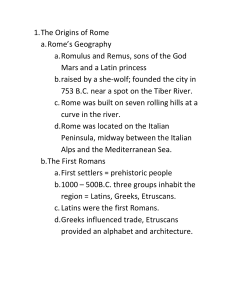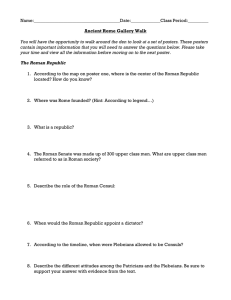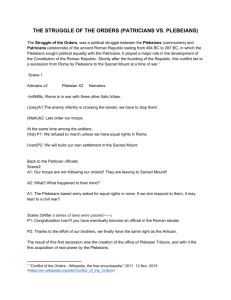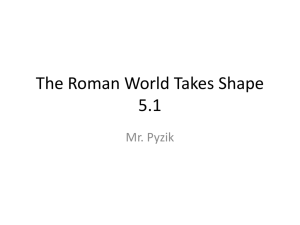Chapter 17 Section 1 On the Banks of the Tiber
advertisement
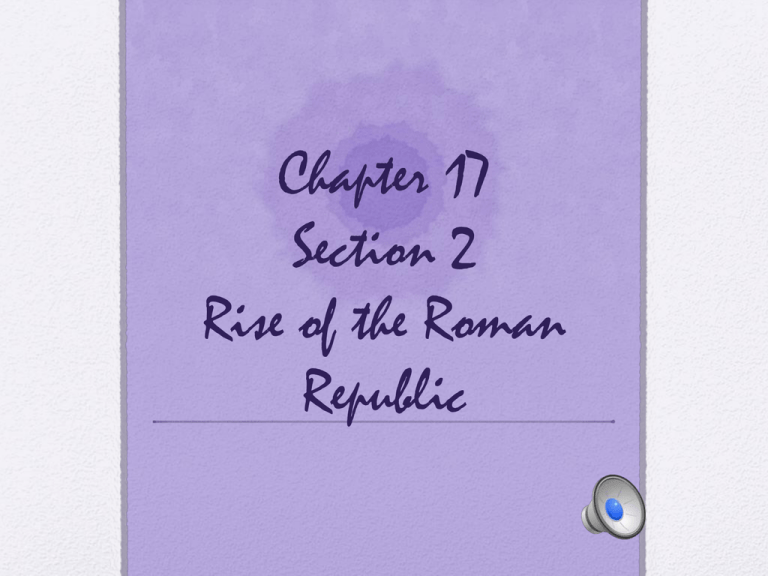
Chapter 17 Section 2 Rise of the Roman Republic Anticipatory Set • The most powerful political leader in the United States in the President. This leader is elected by the citizens of the United States. • Can you predict what problems might arise in the U.S. if it were a monarchy under the rile of a king? • Today we are going to learn how the ancient Romans rebelled against the rule of a monarch and how their government changed as a result Standards • S.S. 6.7.1 • Identify the location and describe the rise of the Roman Republic, including the importance of such mythical and historical figures as Aeneas, Romulus and Remus, Cincinnatus, Julius Caesar, and Cicero. • E-LA Reading 6.1.3 • Recognize the origins and meanings of frequency used foreign words in English and use these words accurately in speaking and writing Objective • Students will learn how the Roman Republic developed Language of the Discipline • Republic • Consul • Patrician • Plebeian • Debt bondage • Tribune From Monarchy to Oligarchy (Input) • The first rulers or Rome were kings • According to tradition, Rome had 7 kings • Some of these rulers, like Romulus, were legendary • Historians do not know if they really existed, but there is some evidence that suggests that the last 3 kings of Rome did exist • These monarchs were known as the the Etruscan kings The Etruscan Kings (Input) • The Etruscan people lived north of Latium in a region called Etruria • They had an older and more advanced culture than the Romans • The Etruscans were great artists, builders, and sailors • They traveled to other lands around the Mediterranean trading goods, ideas, and customs while also learning many things form other cultures The Etruscan Kings (Input) • They expanded into Latium and a leader known as Tarquin the Eder gained power and became Rome’s king • The thrown was later passed down to two other Etruscan monarchs • Each monarch had broad powers • Served as head of the army, chief priest, and supreme judge • Etruscan kings ruled with wealthy aristocrats • Aristocrats formed a body called the Senate • The Senate advised the king on important matters • There was an assembly made of citizens who could bear arms • The king could consult the assembly at any time but the assembly has no real power The Etruscan Kings (Input) Etruscan Improvements (Input) • Etruscan kings brought many changes to Rome like including a writing system adapted from the Greek alphabet • It became the basis for the Latin alphabet which we still use today • The kings brought a strong military tradition to Rome • Their military organization (based on the phalanx) would later expand Rome • They also improved the city by draining the low marshy areas so people could live between the hills • They created a system to carry away wastewater Etruscan Improvements (Input) • They laid out new streets in a rectangular, or grid pattern • They paved the streets with cobblestone and introduced the use of the stone arch in construction in order to support heavy structures such as bridges • The Etruscans also brought their gods and religious practices • One ritual called augury was used to predict the future • Special priests used methods to read the will of the gods • One method involved the flight patterns of birds and another to examine animal intestines • Augury remained an important part of Roman culture • Etruscan influence did not cause the Romans to abandon their own culture Etruscan Improvements (Input) Formation of the Republic (Input) • When the third Etruscan king, Tarquin the Proud, came to rule, the Romans got tired of Etruscan rule • He was so harsh that it lead to a Roman revolt and the Romans overthrew the king, establishing a Roman Republic • A republic is a government in which citizens have the right to vote and elect officials • The word republic comes from the Latin term res publica which means “public things” or “public affairs” • Even though citizens a a role in civic life the Republic was not a democracy Formation of the Republic (Input) • In the early Republic 2 officials called consuls took over the jobs the king used to do • The consuls stood as the highest officials in the Roman government • Their authority was limited, the aristocratic Senate has most of the power • They passed laws and ran the government • Although the assembly still existed, it was becoming controlled by aristocrats The Struggle of the Orders (Input) • Before the rise of the Republic, Rome was divided into 2 main groups called orders • One order was the patricians who represented the upper class of Roman society • Patricians took great pride in belonging to noble families with famous or influential ancestors • The other order was the plebeians, or the common people of Rome • Plebeians were 90% of the population • Some were wealthy but most were ordinary farmers, artisans, and workers • Differences in the orders eventually led to conflict known as the Struggle of the Orders Patricians and Plebeians (Input) • Roman society and government strongly favored the patricians • Patricians ran the government through their control of the Senate • They were leaders of Rome’s social and economic life • The Plebeians had little power or influence • They could not hold political office or serve as priests • They could not advance politically by marrying a patrician. Marriage between orders was prohibited Patricians and Plebeians (Input) • They had little influence on economic life • Most worked as poor peasants farmers. In poor harvest years they had to take out loans to survive • If they could not pay their debt they were sold into slavery • The practice of enslaving people who cannot pay their debts is known as debt bondage • Debt bondage became common and life for plebeians became worse The Plebeians Rebel (Input) • The plebeians began to rebel carrying out random acts of violence against patricians • They realized that the patricians did govern Rome, but could not do it without the plebeian soldiers • Plebeian soldiers went on strike and while Rome was planning to expand their land, they realized they needed to listen to the plebeians to gain their help • The plebeians demanded real power for the common people. Therefore, an assembly known as the Tribal Assembly became part of Rome’s government • The top officials of the plebeian assembly were called tribunes • They had the power to block laws they saw as unfair The Twelve Tables (Input) • 2 decades later the plebeians won another major reform which concerned Rome’s legal system • Roman law consisted of ancient customs but none were written down • This allowed judges to choose which laws to follow and which to ignore • Plebeians demanded a written law code • The first law code was known as the Twelve Tables because it was written on 12 tablets • The new code listed rights and duties of Roman citizens, such as the right to take anyone to court • The Roman Republic still concentrated on governing power from the patricians, but slowly was moving into a democracy The Twelve Tables (Input) Check for Understanding • Please determine the BEST answer for the following question. • Please write your answer on your white boards and wait for the teacher’s signal. • On the teacher’s signal, hold up your white boards. Checking for Understanding #1 Fill in the blank • _______________ are the common people of Rome. • Plebeians Checking for Understanding #2 Answer the following question. •The government of Rome began with________________. •Etruscan kings Checking for Understanding #3 Answer the following question. •What did the Twelve Tables do? • Created the first written laws Guided Practice/Independent Practice • Guided Practice • Complete questions 1 - 3 on the reading comprehension worksheet. • Raise your hand and wait to get stamped. • If you received an “R” go to the back table with Ms. Graham. • Independent Practice • Once you have been stamped moved to independent practice and complete numbers 4 and 5 on the reading comprehension worksheet. • Homework • Note-taking guide on the reverse side.
